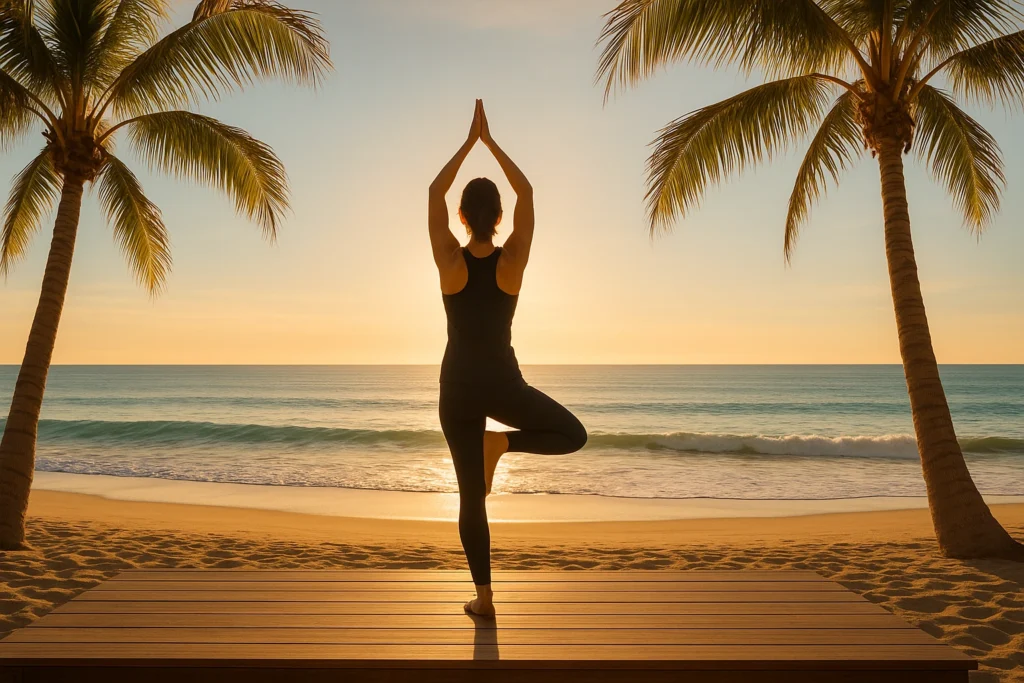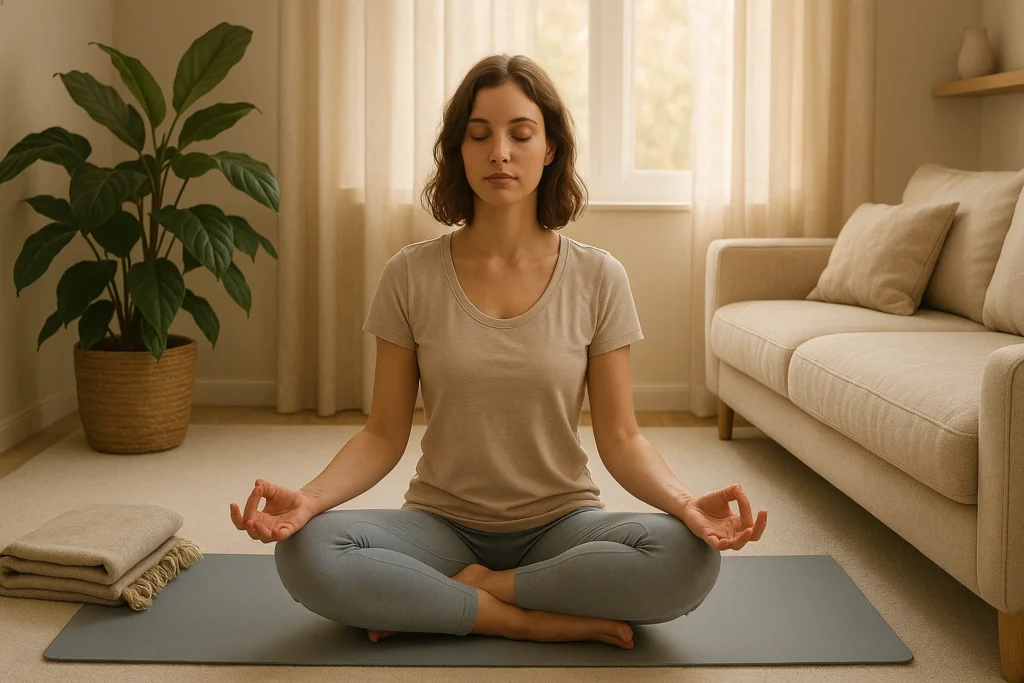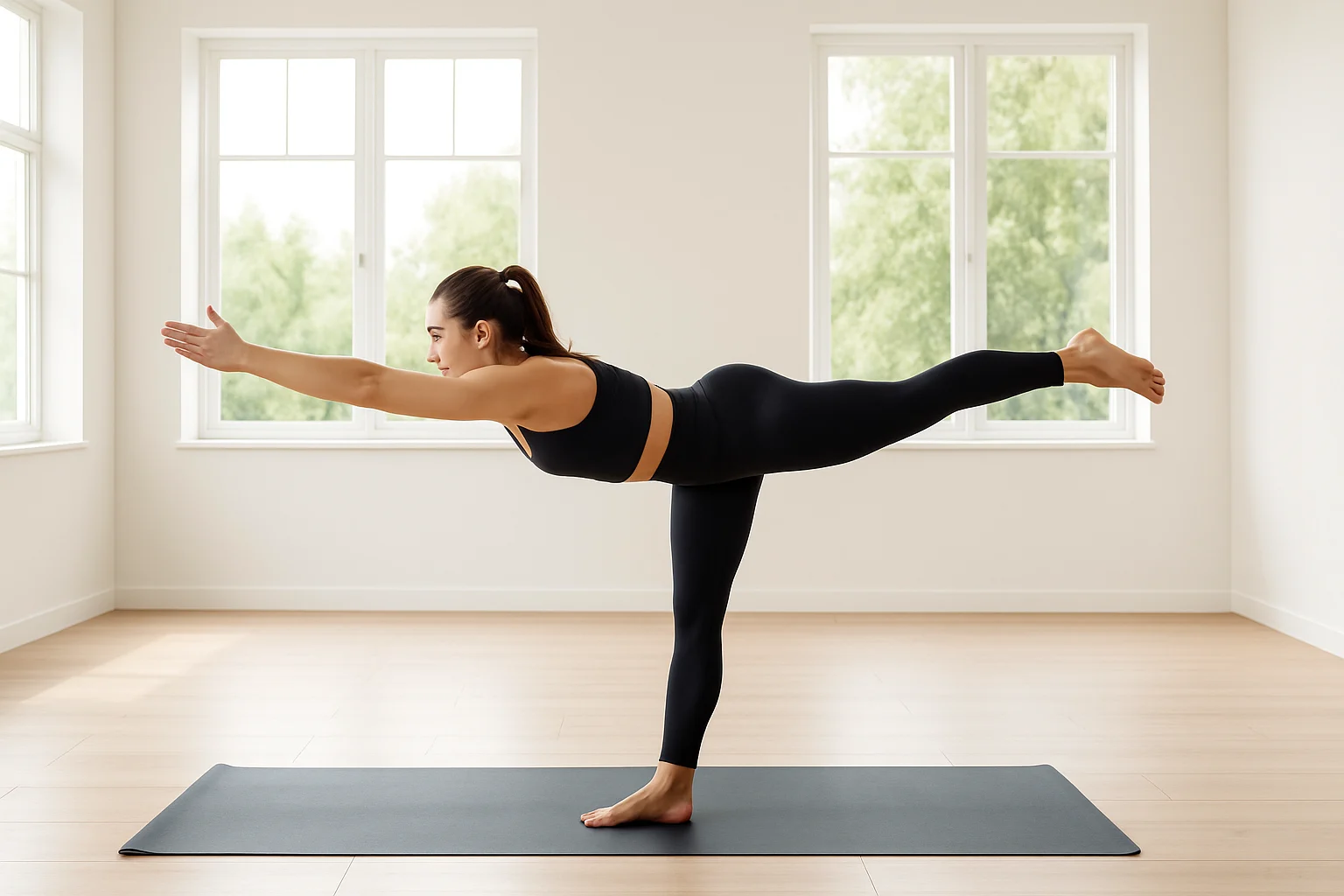
Sculpt powerful glutes with this yoga glutes workout—no gym or weights required. Tired of lower back discomfort or weak glutes slowing you down? Within a few weeks, this yoga routine may help strengthen your backside, support balance, and build confidence. For example, poses like Chair, Warrior III, and Bridge target all three glute muscles to build functional strength and flexibility. Meanwhile, yoga’s mind-body focus helps you engage your glutes effectively. Sarah, a busy mom, noticed more tone and less back discomfort after about a month—your experience may vary. Start your journey to a stronger you below. If you’re also working on mobility, see our comprehensive yoga flexibility guide—it pairs well with this routine.
Table of Contents
- Key Takeaways from This Yoga Glutes Workout
- Why Try a Yoga Glutes Workout?
- Glute Anatomy 101: Know Your Powerhouse
- Yoga Basics for Beginners
- Preparing for Your Glute-Focused Yoga Practice
- Complete Glute-Building Flow: Poses for Power & Tone
- Yoga Glutes Workout Flow
- Consistency is Key for Glute Strength
- Frequently Asked Questions
- Track Your Progress with the Glutes Strength Tracker
- Beyond the Mat: Lifestyle Tips for Strong Glutes
- Conclusion: Empower Your Movement
Key Takeaways from This Yoga Glutes Workout
- Holistic Strength: This glute-strengthening yoga flow builds muscle while also improving flexibility, balance, and core stability so you stand taller and feel stronger.
- Targeted Poses: Chair, Warrior III, Bridge, and Goddess activate all glute muscles effectively.
- Consistency Matters: Roll out your mat 3–4 times a week, give your body rest days, and watch your glutes grow stronger and more defined.
- Mind-Body Focus: Yoga enhances glute engagement, making your workouts more effective.
- Functional Benefits: Strong glutes improve daily movements, athletic performance, and injury prevention.
Summary: This butt workout yoga routine blends strength, balance, and flexibility to shape a stronger backside—so you feel steadier in and out of class.
Why Try a Yoga Glutes Workout?
If you love squats and lunges, keep them—but a glute-toning yoga sequence gives you another path to a strong, shapely backside without endless reps. Unlike traditional exercises, yoga combines functional strength with flexibility and stability, supporting your entire body. For instance, yoga’s isometric holds often emphasize endurance and stability, which can build glute stamina that weight-room routines sometimes overlook.
Moreover, yoga can help release tight hip flexors, which may inhibit glute function due to prolonged sitting. As a result, your glutes may work more effectively, which may help ease lower back discomfort and support posture. According to Yoga Journal, resources discuss how stabilizing muscles such as the glutes support movement and may help reduce injury risk. Consequently, this practice is great for both beginners and advanced practitioners seeking a holistic workout.
Summary: A glute-focused yoga routine builds strength, flexibility, and stability, supporting overall movement and potentially reducing injury risk.
This post has affiliate links. We may earn a commission. Learn more.
Glute Anatomy 101: Know Your Powerhouse
To maximize your glute strengthening yoga practice, it’s helpful to understand the three gluteal muscles working together:
- Gluteus Maximus: The largest muscle, it powers hip extension (e.g., pushing off when walking) and shapes your backside.
- Gluteus Medius: Located on the outer hip, it supports hip abduction and stabilizes the pelvis during single-leg movements.
- Gluteus Minimus: The deepest muscle, it aids in hip abduction and stabilization, working behind the scenes.
These muscles are essential for walking, running, jumping, and sitting. Strong glutes can support posture, may ease back discomfort, enhance athletic performance, and may help lower the risk of knee and hip issues. Therefore, a well-rounded yoga glutes workout targets all three for balanced strength.
Summary: Understanding the gluteus maximus, medius, and minimus helps you engage them effectively during your yoga practice.
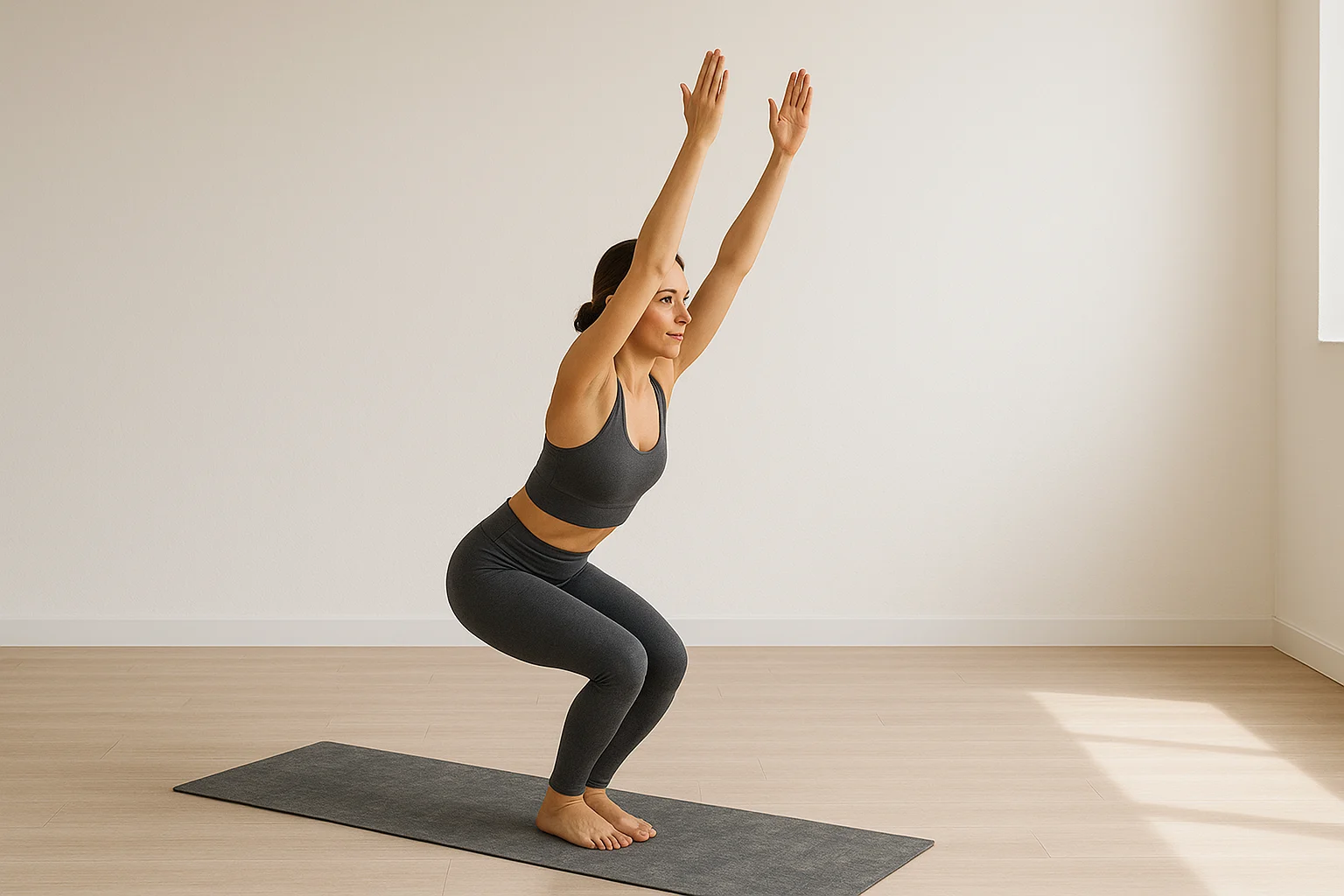
Yoga Basics for Beginners
If you’re new to yoga, here’s a quick guide to common terms in this butt workout yoga routine. “Engage your core” means gently pulling your belly button toward your spine to stabilize your torso. “Hip-width apart” refers to aligning your feet or knees directly under your hips for balance. “Squeeze your glutes” involves consciously tightening your glute muscles to activate them. Meanwhile, “breathe deeply” means slow, controlled breaths to enhance focus and muscle engagement. For example, inhale to prepare, exhale to move into a pose. These basics ensure proper form and safety.
Summary: Mastering these simple terms makes this yoga for strong glutes plan accessible and effective for beginners.
Preparing for Your Glute-Focused Yoga Practice
Warm-Up for a Yoga for Strong Glutes Session
Before starting your yoga for strong glutes session, warm up to increase blood flow and prepare your muscles. For example:
- Gentle Cat-Cow: 5-10 rounds to mobilize the spine.
- Bird-Dog: 5-8 reps per side to activate core and glutes.
- Leg Swings: 10-15 swings per leg to loosen hips.
- Marching in Place: 1-2 minutes to elevate heart rate.
What You’ll Need
- Yoga Mat: For cushioning and grip.
- Comfortable Clothing: Allows full range of motion.
- Water Bottle: Stay hydrated.
- Optional Props: Yoga blocks or a strap for support and deeper stretches.
This routine is perfect for yoga at home, requiring minimal equipment.
Listen to Your Body
Find your edge—where you feel a challenge but not pain. If a pose hurts, ease out or modify it. Everyone’s body is unique, so adapt as needed.
Summary: Proper warm-up, minimal equipment, and body awareness set you up for a safe, effective yoga glutes workout.
The Ultimate Glute Strengthening Yoga Routine: Poses for Power & Tone
These glute-toning yoga poses target all three glute muscles. Focus on engagement for maximum results.
1. Chair Pose (Utkatasana)
How to Do It
Chair Pose fires up your gluteus maximus and quads, mimicking sitting in a chair:
- Stand with feet hip-width apart or together.
- Inhale, sweep arms overhead, palms facing each other.
- Exhale, bend knees deeply, sitting back.
- Shift weight into heels, keeping chest lifted.
- Engage core and squeeze glutes.
- Hold for 5-10 breaths.
Engagement Tips
Press feet into the floor, lift toes slightly, and keep weight in heels. This strengthens glutes and stabilizes hips.
Modifications
Don’t bend as deeply or sit against a wall for support.
Advancements
Lift heels or try one-legged Chair Pose. Enhances balance and glute strength.
Functional Benefits
Improves squat strength and posture for daily activities like sitting and standing.
2. Warrior III (Virabhadrasana III)
How to Do It
This balancing pose strengthens gluteus medius and minimus:
- From Warrior I, shift weight onto right foot.
- Exhale, tilt torso forward, lifting left leg back.
- Extend arms forward or to sides.
- Flex lifted foot, press through heel.
- Keep hips level, engaging standing glute.
- Hold for 3-5 breaths, switch sides.
Engagement Tips
Press through lifted heel and draw standing hip inward to stabilize.
Modifications
Use blocks under hands or lift leg lower.
Advancements
Hold light weights or close eyes for balance challenge.
Functional Benefits
Enhances single-leg stability, crucial for walking and running.
3. Bridge Pose (Setu Bandhasana)
How to Do It
Bridge Pose targets gluteus maximus, hamstrings, and pelvic floor:
- Lie on back, knees bent, feet hip-width apart.
- Press feet into mat, inhale, lift hips.
- Lift until thighs are parallel to floor.
- Squeeze glutes at the top.
- Hold for 5-10 breaths, lower slowly.
Engagement Tips
Keep knees over ankles, press into big toe mounds.
Modifications
Place a block between thighs to engage inner thighs.
Advancements
Lift one leg, keeping hips level, for single-leg bridge.
Functional Benefits
Strengthens pelvic floor and supports lower back health.
4. Goddess Pose (Utkata Konasana)
How to Do It
Goddess Pose builds gluteus maximus and medius:
- Stand with feet 3-4 feet apart, toes at 45 degrees.
- Bend knees deeply, sinking hips.
- Keep torso upright, hands at heart center.
- Squeeze glutes as you sink lower.
- Hold for 5–10 breaths; add gentle pulses if you’d like more challenge.
Engagement Tips
Gently press your knees toward the little toes and lengthen your tailbone.
Modifications
Stay a bit higher, or rest your hands on your thighs for support.
Advancements
Try lifting your heels or adding small pulses to turn up the heat.
Functional Benefits
Can improve hip mobility and leg strength, supporting running, lifting, and more.
5. Low Lunge (Anjaneyasana) with Glute Focus
How to Do It
Stretches hip flexors while strengthening front leg’s glutes:
- From Downward Dog, step right foot forward.
- Lower left knee to mat, pad if needed.
- Keep right knee over ankle, lift torso.
- Draw right heel back to squeeze glute.
- Hold for 5-8 breaths, switch sides.
Engagement Tips
Engage core, press through front foot for stability.
Modifications
Use blocks under hands for balance.
Advancements
Lift back knee for High Lunge.
Functional Benefits
Improves hip flexibility, aiding in walking and running.
6. Half Moon Pose (Ardha Chandrasana)
How to Do It
This balancing pose strengthens gluteus medius:
- From Triangle Pose, shift weight to right foot.
- Place right hand on floor or block.
- Lift left leg parallel to floor, open hip.
- Extend left arm upward, flex lifted foot.
- Engage standing glute, hold for 3-5 breaths.
- Switch sides.
Engagement Tips
Press standing foot down, focus on a fixed point.
Modifications
Use a wall or block for balance.
Advancements
Lift bottom hand briefly.
Functional Benefits
Enhances hip stability, which may help reduce fall risk.
7. Locust Pose (Salabhasana)
How to Do It
Strengthens gluteus maximus and hamstrings:
- Lie on belly, arms alongside body.
- Inhale, lift head, chest, and legs.
- Squeeze glutes to lift legs higher.
- Hold for 3-5 breaths, lower slowly.
Engagement Tips
Lengthen spine, press pubic bone into mat.
Modifications
Lift only upper body or legs.
Advancements
Hold longer or lift higher.
Functional Benefits
Strengthens posterior chain for better posture.
8. Fire Hydrant (Modified Tabletop)
How to Do It
Targets gluteus medius for hip stability:
- Start in tabletop position.
- Lift right knee to side, keeping it bent.
- Keep hips level, squeeze outer glute.
- Lower knee slowly, 8-12 reps per side.
Engagement Tips
Move slowly, imagine a glass of water on your back.
Modifications
Lift knee lower or use a wall for balance.
Advancements
Add a resistance band above knees.
Functional Benefits
Improves hip stability for walking and running.
9. Donkey Kicks (Modified Tabletop)
How to Do It
Strengthens gluteus maximus for shape:
- In tabletop, flex right foot.
- Press heel toward ceiling, squeeze glute.
- Lower knee without touching mat, 8-12 reps.
- Switch sides.
Engagement Tips
Lead with heel, keep core tight.
Modifications
Lift lower.
Advancements
Add a resistance band.
Functional Benefits
Can help with power for jumping and climbing.
10. One-Legged King Pigeon Prep (Eka Pada Rajakapotasana Prep)
How to Do It
Stretches glutes for recovery:
- From Downward Dog, bring right knee to right wrist.
- Place right ankle near left wrist or hip.
- Extend left leg back, hip down.
- Stay upright or lower torso.
- Hold for 1-3 minutes, switch sides.
Engagement Tips
Keep back hip squared, relax into stretch.
Modifications
Use a blanket under hip or do figure-four stretch.
Advancements
Deepen stretch by lowering further.
Functional Benefits
Improves hip flexibility, aiding recovery.
Summary: These poses create a balanced glute-focused yoga sequence, strengthening and stretching for optimal results.
Yoga Glutes Workout Flow
Combine these poses into a 45–60-minute glute-focused yoga session you can do 3–4 times weekly:
Warm-Up (5-7 Minutes)
- Gentle Cat-Cow (5-10 rounds)
- Bird-Dog (5-8 reps per side)
- Leg Swings (10-15 per leg)
- Sun Salutation A (2-3 rounds)
Standing Glute Power (20-25 Minutes)
- Chair Pose: 5-10 breaths, 2-3 sets.
- Warrior III: 3-5 breaths per side, 2-3 sets.
- Goddess Pose: 5-10 breaths with pulses, 2-3 sets.
- Low Lunge: 5-8 breaths per side, 2 sets.
- Half Moon Pose: 3-5 breaths per side, 2 sets.
Floor Glute Sculpt (15-20 Minutes)
- Bridge Pose: 5-10 breaths or 10-15 pulses, 3-4 sets.
- Locust Pose: 3-5 breaths, 2-3 sets.
- Fire Hydrant: 8-12 reps per side, 2-3 sets.
- Donkey Kicks: 8-12 reps per side, 2-3 sets.
Cool-Down & Stretch (5-7 Minutes)
- One-Legged King Pigeon Prep: 1-3 minutes per side.
- Supine Figure Four Stretch: 1-2 minutes per side.
- Happy Baby Pose: 1 minute.
- Savasana: 3-5 minutes, ideal among restorative poses for recovery.
Summary: This structured flow balances strength and flexibility for a focused glute strengthening yoga session.
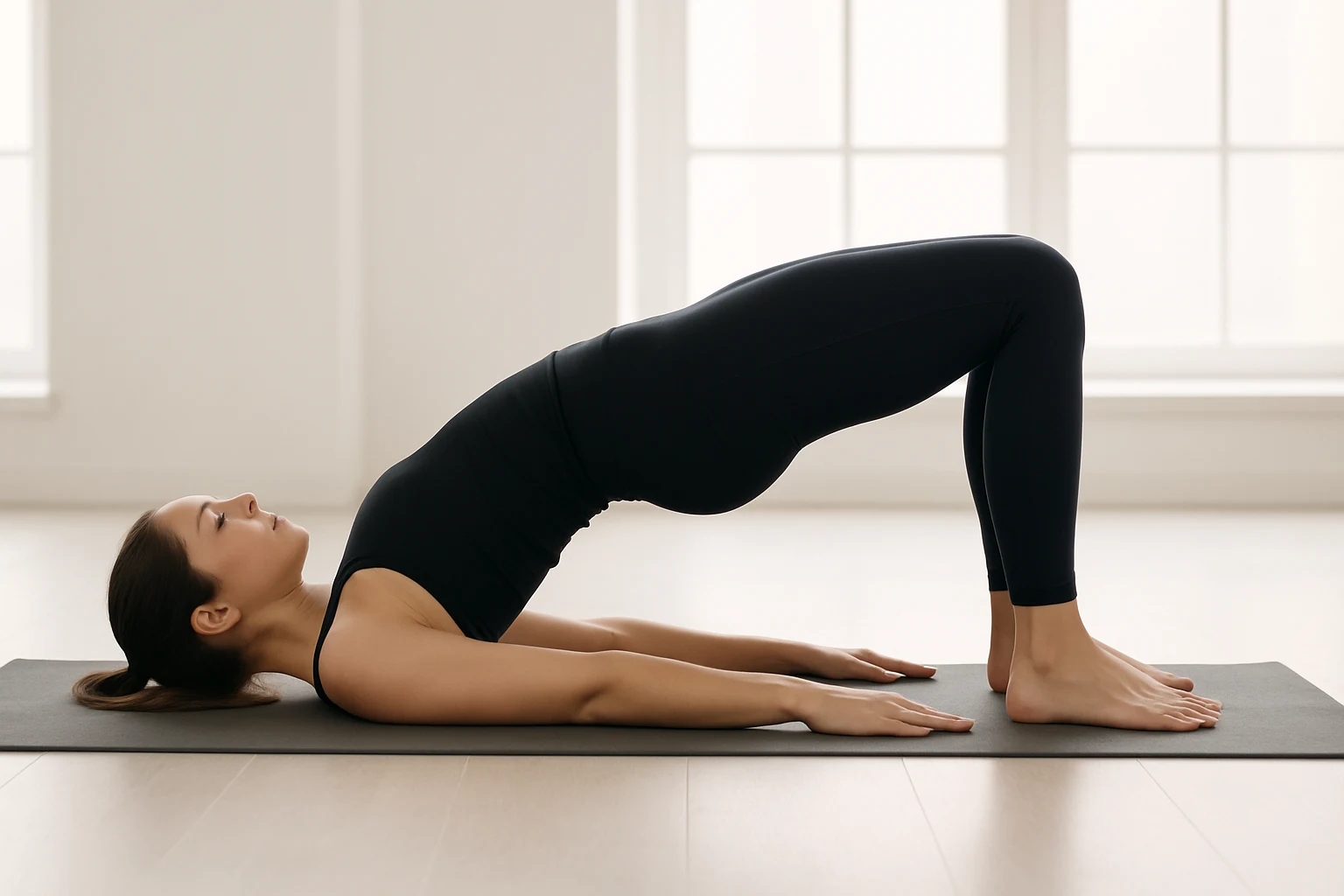
Consistency is Key for Glute Strength
Most people do well with this glute-focused yoga routine 3–4 times a week. Beginners can start with 2–3 sessions, while advanced practitioners can handle 4. Take rest days to support recovery—progress varies, so keep showing up.
Summary: Regular practice with rest days supports glute strength and tone.
Frequently Asked Questions
Track Your Progress with the Glutes Strength Tracker
This tool helps you monitor your glute-toning yoga progress over 4 weeks. Click a cell to mark your session’s status.
Summary: The tracker makes progress visible—simple, motivating, and easy to keep up with.
Beyond the Mat: Lifestyle Tips for Strong Glutes
Enhance your glute-strengthening yoga routine with these lifestyle habits:
- Nutrition: Eat protein (e.g., eggs, beans), complex carbs (e.g., sweet potatoes), and healthy fats (e.g., avocado).
- Hydration: Drink water regularly throughout the day to support muscle function.
- Active Lifestyle: Take stairs, walk, or stand frequently to keep glutes active.
- Mind-Muscle Connection: Squeeze glutes during daily movements like walking.
- Sleep: Aim for 7-9 hours for muscle repair.
Summary: Nutrition, hydration, activity, and sleep amplify the benefits of your glute-strengthening yoga routine.
Conclusion: Empower Your Movement
This glute-focused yoga routine can build a strong, toned backside and may support posture, balance, and confidence. For example, consistent practice of these poses supports daily activities and may help prevent injuries. Therefore, keep practicing, track your progress, and enjoy the journey to a stronger you.
